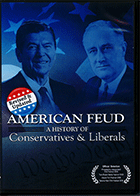
American Feud: A History of Conservatives & Liberals 2017
Distributed by Nerds Make Media
Produced by Richard Hall and Simone Fary
Directed by Richard Hall
, color, 86 min.
High School - General Adult
Government, Political Science
Date Entered: 12/11/2018
Reviewed by Brian Falato, University of South Florida Tampa Campus LibraryAmerica today seems to be sharply divided between the so-called red states, where Republicans reign, and blue states, dominated by Democrats. Republicans are thought of as conservatives, Democrats as liberals. But the meanings associated with these terms has changed over the decades. American Feud provides a history lesson in the development of these terms and their associated parties.
One of the first things mentioned in the documentary is that the colors red and blue have different meanings historically than are ascribed to them today. Political commentator Kevin Phillips points out that red was long associated with Communism, something no Republican would want to be grouped with. And the blue color was associated with conservative Toryism and would be the enemy of policies that Democrats would approve today.
After finding that out, we next learn that “classical liberalism” had a libertarian outlook and supported unfettered free market capitalism. This was the general view of the Democratic Party until late in the 19th century. Republicans were more in favor of economic protectionism than free markets and had a religious conservatism that would go against libertarian social policy.
The excesses of the Gilded Age changed these views. William Jennings Bryan was the Democratic presidential nominee in 1896, 1900, and 1908 and made redistribution of wealth a centerpiece of his campaign. Although he lost each election, he had an influence on Republican positions. Under Republican presidential administrations, the pure food acts were passed, and public health and public welfare were promoted.
The modern liberalism we associate with the Democrats began with Franklin Roosevelt’s election in 1932 and his spearheading of New Deal programs to ease the Great Depression. Acceptance of these programs became broad enough that Republican Dwight Eisenhower rejected calls from some in his party to roll back the Roosevelt-created programs after his election in 1952.
Barry Goldwater provided the seeds for the modern conservative movement in the Republican Party with his 1964 presidential campaign. Although he lost in a landslide, his views gained in popularity as a backlash grew against the social protests and riots of the 1960s and 1970s and perceived excesses of social welfare programs. Ronald Reagan, a 1964 Goldwater supporter, was elected to two terms as President in the 1980s.
Although Roosevelt and Reagan are viewed as ideological champions of their parties, both were willing to make compromises on desired legislation in order to get it passed. By the time Democrat Bill Clinton was elected President in 1992, this cooperative spirt was starting to change. Republican Newt Gingrich developed a strategy to demonize Democrats as an enemy of the country and promote smaller government that would not support the social programs of earlier years. Gingrich’s plan had success when Republicans took control of the House even as Clinton was still President.
Today, the idea of bipartisan cooperation seems more remote than ever. Each party shapes its policies to appeal to its base of supporters (the college-educated and minorities for Democrats, white working-class voters for Republicans) and makes little effort to broaden its appeal.
This documentary was originally released in 2008. It has been reissued with added footage from the presidential campaigns since. By bringing it up to date, it gains more relevance to viewers today. And the documentary should be seen widely. We need the historical perspective, and the interviews with adherents of many different viewpoints shows that individuals can have more nuanced views than the monolithic stances both parties are trying to project.
The DVD contains a number of brief featurettes as extras. Especially informative are examples of the “tribalism” that keeps Republican and Democratic lawmakers from working with each other, and a proposal to broaden the numbers of people voting by making it mandatory. Parties then would not be able to promote the more extreme views that appeal to their base of support but alienate moderate voters. Instead of fining people for not voting, a national lottery is proposed in which entry would be open only to those who voted.
This is a video recommended for many types of libraries, ranging from high schools and colleges to public libraries of various sizes. It provides an important civic education.